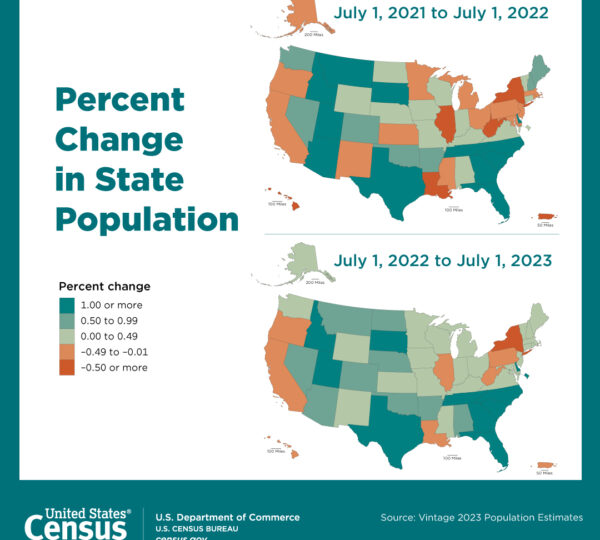For decades, the pathway to the White House for the Democratic Party has relied on a familiar blueprint that has remained remarkably consistent. Large, reliable blue states like California, New York, and Illinois have long formed the foundation of their Electoral College strategy.
With these states firmly in their column, Democrats typically only needed to secure a handful of battlegrounds in the Midwest and Northeast to reach the crucial threshold of 270 electoral votes. But according to recent demographic analyses and political projections, this formula may be nearing its expiration date.
America’s internal migration patterns have shifted dramatically in the last decade. Millions of residents have relocated from high-tax, heavily regulated states toward regions that offer lower costs of living, more affordable housing, and significantly faster economic growth.
States like Texas, Florida, Tennessee, and the Carolinas have become magnets for new arrivals, while states like California, New York, and Illinois are experiencing consistent population losses. These movements are not only reshaping local economies—they are transforming the national political map in ways that could have lasting consequences.

Unlike election cycles where parties rise and fall based on candidates or campaign messaging, demographic change is a slow but powerful force that alters the basic math of politics. Every 10 years, the Census determines how many congressional seats each state receives—a process called apportionment. Since each congressional seat equals one Electoral College vote, population shifts influence presidential elections for an entire decade. Analysts are already anticipating significant adjustments after the 2030 Census.
Early projections suggest that Democratic-leaning states may be among the biggest losers in the next round of reapportionment. California, long the nation’s largest and most influential state, could lose multiple seats as its population stagnates. New York, once a demographic powerhouse, continues to shrink as residents depart for more affordable states. Illinois faces similar challenges, with many families moving out due to taxes and economic pressures. These changes collectively chip away at the Electoral College advantage Democrats have relied on for generations.
Meanwhile, Republican-leaning states stand ready to gain more influence. Texas is projected to add at least two new congressional districts, and Florida is expected to gain at least one. Even smaller states in the South and Mountain West are experiencing growth strong enough to potentially reshape their political weight. This shift means that any party with strong appeal in these fast-growing regions—currently the GOP—enters future elections with a structural advantage.

Democrats today enjoy numerous paths to the presidency because their strongholds hold a large share of the Electoral College. But analysts warn that by 2032, those options may narrow dramatically. If traditionally blue states contribute fewer electoral votes, Democrats will need to compensate by winning more competitive states—states where margins are historically narrow and harder to rely on.
Even if Democrats rebuild their “blue wall” in Michigan, Wisconsin, and Pennsylvania, that may no longer be enough to guarantee victory. They may also need to sweep critical swing states such as Nevada, Arizona, Georgia, and New Hampshire. In this scenario, even a single loss could block their path to 270. Meanwhile, Republicans—should current demographic trends hold—could secure multiple realistic paths to victory, even if they lose a state or two along the way.
But migration alone does not determine political power. Redistricting plays an equally important role. After each Census, state legislatures redraw congressional maps, adjusting district boundaries to reflect population changes. In recent years, however, some states have taken the unusual step of redrawing maps mid-decade, exploiting legal openings to solidify political advantages sooner than expected.

Texas recently demonstrated how powerful mid-decade map changes can be. Governor Greg Abbott signed a new congressional map designed to strengthen Republican control of the state’s delegation—well before the next Census. Backed strongly by former President Donald Trump and national GOP strategists, the new map immediately drew fierce criticism from Democrats and civil rights groups. Opponents argue the changes reduce the voting power of Black communities and dilute Democratic strongholds.
The political fallout was immediate. Longtime Democratic Representative Lloyd Doggett announced he would not seek reelection if the new map remains in place, as his district would be merged with that of another Democrat. Voting rights organizations filed lawsuits challenging the map’s legality, while Texas Democrats staged a dramatic walkout that drew national attention. Yet despite the protests, the new map moved forward, giving Republicans a stronger foothold ahead of the 2026 midterms.
California, which stands to lose congressional seats due to population decline, is also scrambling to protect its political influence. State leaders have launched a special process to redraw district boundaries ahead of schedule—an unusual step aimed at preserving Democratic representation. This action highlights the deep concern within the Democratic Party about the broader demographic shifts.
Other states are joining the fight. Missouri’s governor called a special session to consider new boundaries. In Ohio, Democrats expect Republicans to push a new map that could strengthen GOP control. These actions illustrate how redistricting has become one of the most important political battlegrounds of the decade.

Redistricting battles will inevitably lead to prolonged legal conflicts, and courts will likely shape the outcome in several states. However, no legal ruling can stop the underlying demographic forces. People continue moving from blue states into red or purple states with faster-growing populations. These decisions are driven primarily by economic opportunity, cost of living, and lifestyle preferences—not politics. Yet the long-term political effects are unavoidable.
For Democrats, the challenge is clear: their strongest support remains concentrated in states that are either losing residents or growing slowly. If these states lose electoral votes, Democrats will face a steeper climb to win national elections. They will need broader appeal in regions that have historically leaned Republican or remained highly competitive.
For Republicans, the demographic tailwinds are encouraging. Growth in states like Texas, Florida, Utah, Arizona, and both Carolinas gives the party more flexibility. Even if political shifts make some suburbs more competitive, the overall movement of people benefits GOP-leaning areas.
If these trends continue into the next decade, the 2032 presidential election could be fought on a map far different from what Americans are used to. Democrats may find themselves with fewer solid building blocks, while Republicans enjoy more stable starting points.
In this emerging landscape, traditional political assumptions become less reliable. What once were safe Democratic states may no longer hold the same influence. What once were Republican opportunities may become stronger footholds. And as voters continue to relocate based on economic priorities, these patterns could deepen.
Ultimately, the combination of population shifts, changing state boundaries, and aggressive redistricting efforts suggests that America’s political future will be significantly reshaped in ways that may favor Republicans. While no outcome is guaranteed, the overall momentum appears to be tilting toward the GOP—unless Democrats find new strategies to expand their appeal.

In the end, the coming decade could redefine presidential politics. The old paths to the White House may narrow, new ones may emerge, and the balance of political power may shift as the country continues to evolve. What remains certain is that the 2030 Census—and the strategic decisions that follow—will play a defining role in shaping the future of American democracy.
For decades, the pathway to the White House for the Democratic Party has relied on a familiar blueprint that has remained remarkably consistent. Large, reliable blue states like California, New York, and Illinois have long formed the foundation of their Electoral College strategy.
With these states firmly in their column, Democrats typically only needed to secure a handful of battlegrounds in the Midwest and Northeast to reach the crucial threshold of 270 electoral votes. But according to recent demographic analyses and political projections, this formula may be nearing its expiration date.
America’s internal migration patterns have shifted dramatically in the last decade. Millions of residents have relocated from high-tax, heavily regulated states toward regions that offer lower costs of living, more affordable housing, and significantly faster economic growth.
States like Texas, Florida, Tennessee, and the Carolinas have become magnets for new arrivals, while states like California, New York, and Illinois are experiencing consistent population losses. These movements are not only reshaping local economies—they are transforming the national political map in ways that could have lasting consequences.

Unlike election cycles where parties rise and fall based on candidates or campaign messaging, demographic change is a slow but powerful force that alters the basic math of politics. Every 10 years, the Census determines how many congressional seats each state receives—a process called apportionment. Since each congressional seat equals one Electoral College vote, population shifts influence presidential elections for an entire decade. Analysts are already anticipating significant adjustments after the 2030 Census.
Early projections suggest that Democratic-leaning states may be among the biggest losers in the next round of reapportionment. California, long the nation’s largest and most influential state, could lose multiple seats as its population stagnates. New York, once a demographic powerhouse, continues to shrink as residents depart for more affordable states. Illinois faces similar challenges, with many families moving out due to taxes and economic pressures. These changes collectively chip away at the Electoral College advantage Democrats have relied on for generations.
Meanwhile, Republican-leaning states stand ready to gain more influence. Texas is projected to add at least two new congressional districts, and Florida is expected to gain at least one. Even smaller states in the South and Mountain West are experiencing growth strong enough to potentially reshape their political weight. This shift means that any party with strong appeal in these fast-growing regions—currently the GOP—enters future elections with a structural advantage.

Democrats today enjoy numerous paths to the presidency because their strongholds hold a large share of the Electoral College. But analysts warn that by 2032, those options may narrow dramatically. If traditionally blue states contribute fewer electoral votes, Democrats will need to compensate by winning more competitive states—states where margins are historically narrow and harder to rely on.
Even if Democrats rebuild their “blue wall” in Michigan, Wisconsin, and Pennsylvania, that may no longer be enough to guarantee victory. They may also need to sweep critical swing states such as Nevada, Arizona, Georgia, and New Hampshire. In this scenario, even a single loss could block their path to 270. Meanwhile, Republicans—should current demographic trends hold—could secure multiple realistic paths to victory, even if they lose a state or two along the way.
But migration alone does not determine political power. Redistricting plays an equally important role. After each Census, state legislatures redraw congressional maps, adjusting district boundaries to reflect population changes. In recent years, however, some states have taken the unusual step of redrawing maps mid-decade, exploiting legal openings to solidify political advantages sooner than expected.

Texas recently demonstrated how powerful mid-decade map changes can be. Governor Greg Abbott signed a new congressional map designed to strengthen Republican control of the state’s delegation—well before the next Census. Backed strongly by former President Donald Trump and national GOP strategists, the new map immediately drew fierce criticism from Democrats and civil rights groups. Opponents argue the changes reduce the voting power of Black communities and dilute Democratic strongholds.
The political fallout was immediate. Longtime Democratic Representative Lloyd Doggett announced he would not seek reelection if the new map remains in place, as his district would be merged with that of another Democrat. Voting rights organizations filed lawsuits challenging the map’s legality, while Texas Democrats staged a dramatic walkout that drew national attention. Yet despite the protests, the new map moved forward, giving Republicans a stronger foothold ahead of the 2026 midterms.
California, which stands to lose congressional seats due to population decline, is also scrambling to protect its political influence. State leaders have launched a special process to redraw district boundaries ahead of schedule—an unusual step aimed at preserving Democratic representation. This action highlights the deep concern within the Democratic Party about the broader demographic shifts.
Other states are joining the fight. Missouri’s governor called a special session to consider new boundaries. In Ohio, Democrats expect Republicans to push a new map that could strengthen GOP control. These actions illustrate how redistricting has become one of the most important political battlegrounds of the decade.

Redistricting battles will inevitably lead to prolonged legal conflicts, and courts will likely shape the outcome in several states. However, no legal ruling can stop the underlying demographic forces. People continue moving from blue states into red or purple states with faster-growing populations. These decisions are driven primarily by economic opportunity, cost of living, and lifestyle preferences—not politics. Yet the long-term political effects are unavoidable.
For Democrats, the challenge is clear: their strongest support remains concentrated in states that are either losing residents or growing slowly. If these states lose electoral votes, Democrats will face a steeper climb to win national elections. They will need broader appeal in regions that have historically leaned Republican or remained highly competitive.
For Republicans, the demographic tailwinds are encouraging. Growth in states like Texas, Florida, Utah, Arizona, and both Carolinas gives the party more flexibility. Even if political shifts make some suburbs more competitive, the overall movement of people benefits GOP-leaning areas.
If these trends continue into the next decade, the 2032 presidential election could be fought on a map far different from what Americans are used to. Democrats may find themselves with fewer solid building blocks, while Republicans enjoy more stable starting points.
In this emerging landscape, traditional political assumptions become less reliable. What once were safe Democratic states may no longer hold the same influence. What once were Republican opportunities may become stronger footholds. And as voters continue to relocate based on economic priorities, these patterns could deepen.
Ultimately, the combination of population shifts, changing state boundaries, and aggressive redistricting efforts suggests that America’s political future will be significantly reshaped in ways that may favor Republicans. While no outcome is guaranteed, the overall momentum appears to be tilting toward the GOP—unless Democrats find new strategies to expand their appeal.

In the end, the coming decade could redefine presidential politics. The old paths to the White House may narrow, new ones may emerge, and the balance of political power may shift as the country continues to evolve. What remains certain is that the 2030 Census—and the strategic decisions that follow—will play a defining role in shaping the future of American democracy.
